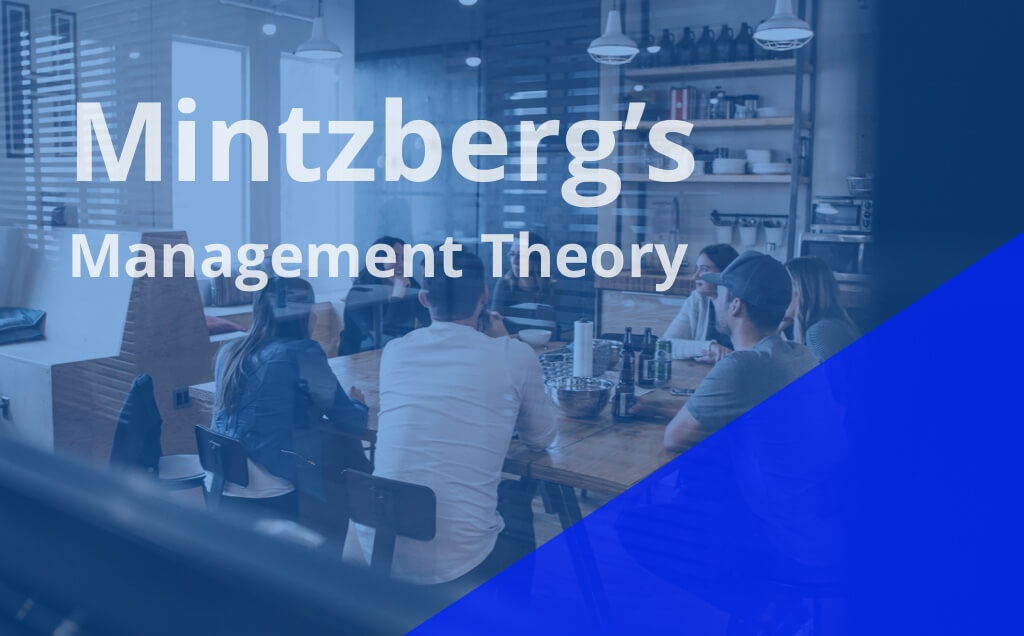what are mintzberg’s ten managerial roles?
Henry Mintzberg’s ten managerial roles are:
- Figurehead
- Leader
- Liaison
- Monitor
- Disseminator
- Spokesperson
- Entrepreneur
- Disturbance Handler
- Resource Allocator
- Negotiator
We’ve covered many leaders in the development of management theory on this site, from Frederick Taylor to Robert Kahn.
Henry Mintzberg is a different case since he is still active teaching and writing to this day, producing academic papers and books as well as practical guides like his 2019 book Bedtime Stories for Managers.
In the context of management theory, Henry Mintzberg is best known for three pieces of work:
- The Nature of Managerial Work (1973)
- The Structuring of Organizations: Synthesis of Research (1979)
- The Rise and Fall of Planning (1994)
From these works, he has become known for his unique views on management and strategy, including his “Five Organizational Configurations,” “Five Minds of a Manager,” “Ten Roles of a Manager,” and perspectives on “Crafting Strategy.”1
- Who Henry Mintzberg is
- The Five Organizational Configurations
- The Five Minds of a Manager
- The Ten Roles of a Manager
- Crafting Strategy
Who is Henry Mintzberg?
Henry Mintzberg (1939) was born in Montreal, Canada. After completing a Bachelor of Engineering at McGill University in 1961, he worked for Canadian National Railways for two years while simultaneously earning a Bachelor of General Arts from Sir George Williams (now Concordia) University.
Next, Mintzberg completed his Master of Science at the Massachusetts Institute of Technology (MIT) in 1965 and later a Ph.D in Management at the Sloan School of Management.
Since then, he has been working as a professor of Management Studies at McGill University and spent time as a visiting professor at various other universities (including INSEAD).
Five Organizational Configurations
According to Mintzberg, in order for an organization to be efficient and effective at accomplishing a given task, the organization’s design must be consistent, be coherent, and fit.2
Mintzberg says that consistent and coherent organizational design comes in “one of five natural configurations, each a combination of certain elements of structure and situation.”
The following chart lists the various component parts, elements of structure, situational factors, and five natural configurations:
| Component Parts | Structural Elements | Situational Elements | Natural Configurations |
|
|
|
|
In the subsections that follow, I’ll describe each of the component parts, elements of structure, and situational factors, as well as summarize the five natural configurations. Then, in the final subsection, I’ll provide an easy-to-use reference chart that lists the structural and situational elements of the Five Organizational Configurations.
For more detailed descriptions of all elements and configurations, see the original article, “Organization Design: Fashion or Fit?”
Component Parts
The following chart describes each of the component parts of organizational design.
| Component Parts | Description |
| Strategic apex | Top management |
| Operating core | “People [who] do the basic work of the organization” |
| Middle line | Managers between top management and the workers |
| Technostructure | “Analysts who design systems concerned with the formal planning and control of the work” |
| Support staff | Those who provide “indirect services to the rest of the organization” |
Structural Elements
The following chart describes each of the structural elements of organizational design.
| Structural Element | Description |
| Specialization of jobs |
|
| Training and indoctrination |
|
| Formalization of behavior |
|
| Grouping |
|
| Unit size |
|
| Planning and control systems |
|
| Liaison devices |
|
| Decentralization |
|
Situational Elements
The following chart describes each of the situational elements of organizational design.
| Situational Element | Description |
| Age and size |
|
| Technical system |
|
| Environment |
|
| Power |
|
Natural Configurations
The following chart describes each of the five natural organizational configurations that form from the preceding structural and situational elements.
| Natural Configuration | Description |
| Simple structure |
|
| Machine bureaucracy |
|
| Professional bureaucracy |
|
| Divisionalized form |
|
| Adhocracy |
|
In order to use these Five Organizational Configurations, a manager will compare their own organization’s design to the most appropriate one of the five organizational configurations. Then, they can determine where their organization’s component parts do not align so that improvements can be made. When doing this, the manager should ensure that:3
- Internal elements are consistent;
- External controls are functional;
- All component parts fit; and
- Structure matches the situation.
The Manager and Their Job
In his work, Mintzberg describes the manager as a mind separate from the manager as a role. Here’s a breakdown of each perspective:
The Five Minds of a Manager
Mintzberg (and Jonathan Gosling) determined that the managerial mind requires one to have broad knowledge and experience, reflect on this knowledge and experience, analyze the situation, collaborate with others, and act.
These “five ways in which managers interpret and deal with the world around them” are referred to as the “five sets of the managerial mind.” In turn, “each [set] has a dominant subject, or target, of its own” and can be paired in a prescriptive sort of fashion, as seen in the chart below.4
| Function | Target | |
| Have broad knowledge and experience
(Worldly mind set) |
to | Manage the Context |
| Reflect
(Reflective mind set) |
to | Manage the Self |
| Analyze
(Analytic mind set) |
to | Manage the Organization |
| Collaborate
(Collaborative mind set) |
to | Manage Relationships |
| Act
(Action mind set) |
to | Manage Change |
Mintzberg states that an effective manager requires all of these skill sets. Furthermore, an organization’s management must “combine their reflective actions in analytic, worldly ways”; more simply put, effective organizations require their managers to “understand one another and combine their strengths.” Gosling, 2003)
The Ten Roles of a Manager
Mintzberg defines a manager as “a person in charge of an organization or subunit.” As a result, this means that the title is applicable to countless people with formal authority and status. He states that these individuals have ten integrated managerial roles that can be categorized into three groups. The ten roles and corresponding groups are as follows:
| Interpersonal Roles | Informational Roles | Decisional Roles |
|
|
|
Like the aforementioned “five minds,” Mintzberg states that all of these roles are required of a manager; that is, no one role can be removed. Similarly, roles cannot be divided unless they are “very carefully [reintegrated]” and cannot be shared unless all people fully communicate all information and “act as one entity.”
Interpersonal Roles
According to Mintzberg, interpersonal roles “arise directly from formal authority and involve basic interpersonal relationships.”
The figurehead role consists of representing the organization through formal/ceremonial duties, like greeting and giving a tour to a potential business partner.
The leader role consists of direct leadership, like hiring and training, and indirect leadership, like the motivation and encouragement of employees. In effect, “leadership determines in large part how much of [a manager’s potential power is realized].”
And the liaison role consists of making contact “outside the vertical chain of command,” since “managers spend as much time with peers and other people outside their units as they do with their own subordinates” and “very little time with their own superiors.”
Informational Roles
Informational roles are those that are associated with gathering, analyzing, organizing, storing, and distributing knowledge.
The monitor role consists of “perpetually scanning the environment for information, interrogating liaison contacts and subordinates, and receiving unsolicited information.”
The disseminator role consists of passing on “privileged information directly to subordinates” or between subordinates when they “lack easy contact with one another.”
And the spokesperson role consists of sending information to people inside and outside the organizational unit, like a public speech, a presentation to shareholders, or communication with a subordinate manager.
Decisional Roles
Decisional roles are those associated with making and implementing high-level business decisions.
The entrepreneur role consists of actions associated with improving one’s unit and adapting it “to changing conditions in the environment.” This includes creating new products or processes, reorganizing a weak department, mergers and acquisitions, and other projects.
The disturbance handler role consists of responding to changes “beyond the manager’s control,” like when “a strike looms, a major customer has gone bankrupt, or a supplier reneges on a contract.”
The resource allocator role consists of determining the organizational structure, “deciding who will get what,” and ensuring that interrelationships are coherent.
Finally, the negotiator role consists of using important information and committing organizational resources when solving problems or forming agreements.
Crafting Strategy
As mentioned previously, Mintzberg is also known for his unique contributions to business strategy. In the following subsections, I’ll cover Mintzberg’s perspectives on strategy and the strategist.5
Perspectives on Strategy
Traditionally speaking, strategy is seen as being planned. This involves “the systematic analysis of competitors and markets, of company strengths and weaknesses, [and] the combination of these analyses producing clear, explicit, full-blown strategies.”
Mintzberg defines this as “deliberate strategy.” Conversely, Mintzberg argues that strategy should be crafted to some degree, where “formulation and implementation merge into a fluid process of learning through which creative strategies evolve”; in other words, where action drives thinking and strategies “emerge.” He defines this as “emergent strategy.”
Mintzberg believes that strategy requires a combination of these two approaches, where an organization benefits from the controlling features of a deliberate strategy and the learning features of an emergent strategy. This is because not everything can be known and planned in advance and too much flexibility will result in a lack of clear direction. Thus, Mintzberg states that strategies sit at some point within a continuum, between deliberate at one end and emergent at the other.
Moreover, Mintzberg offers two examples of effective strategies: 1. umbrella strategy; and 2. process strategy. Each can be defined as follows:
- Umbrella strategy involves “[setting] out broad guidelines (say, to produce only high-margin products at the cutting edge of technology or to favor products using bonding technology) and leaves the specifics (such as what these products will be) to others lower down in the organization. This strategy is not only deliberate (in its guidelines) and emergent (in its specifics), but it is also deliberately emergent in that the process is consciously managed to allow strategies to emerge en route.”
- Process strategy involves “[controlling] the process of strategy formation—[i.e.] with the design of the structure, [staffing], procedures, and so on—while leaving the actual content to others.” This is where “people way down in the hierarchy who are in touch with the situation at hand and have the requisite technical expertise” are both strategic formulators and implementors.
Perspectives on the Strategist
Given his unique views on strategy, it is not surprising that Mintzberg also has unique views on the strategist. Rather than seeing them as “a planner or…visionary, [sitting] on a pedestal dictating brilliant strategies for everyone else to implement,” he believes that the strategist should be seen “as a pattern recognizer, a learner if you will, who manages a process in which strategies (and visions) can emerge as well as be deliberately conceived… This strategist finds strategies no less than creates them, often in patterns that form inadvertently in its own behavior.”
Mintzberg states that managers who craft strategy should be “[intimately] involved, [harmoniously] responsive to their materials, learning about their organizations and industries through personal touch.” Moreover, they should be “managing stability, not change”; “they should be getting on with making their organizations as effective as possible in pursuing the strategies they already have.” Thus, in summary, Mintzberg believes that:
- Strategic planning is “not to create a strategy, but to program a strategy already created—to work out its implications formally”; and
- “To manage strategy…is not so much to promote change as to know when to do so.”
Article Summary
To recap, in this post, we covered:
- Who Henry Mintzberg is;
- The component parts, structural elements, and situational elements of the Five Organizational Configurations;
- The Five Minds of a Manager;
- Mintzberg’s managerial roles; and
- Crafting Strategy.
As you’ve discovered, Mintzberg offers some unique perspectives that provide valid challenges or alternatives to many management theories of the past. Therefore, it is no wonder why Mintzberg is recognized as a noteworthy contributor to management theory.
 Patrick Ward
Patrick Ward 

 IaaS vs SaaS vs PaaS: What's the Difference?
IaaS vs SaaS vs PaaS: What's the Difference?